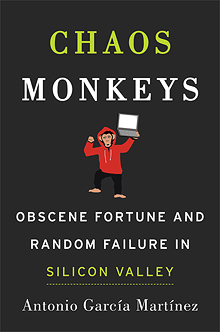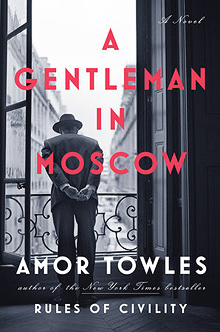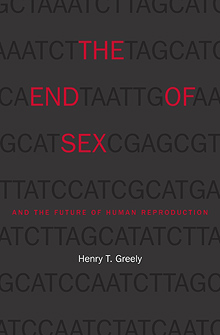 The End of Sex and the Future of Human Reproduction By Henry T. Greely Harvard ~ 2016 ~ 381 pp. $35 (cloth) |
In The End of Sex, Stanford University law professor and bioethicist Hank Greely makes the case that the emerging technology of in vitro gametogenesis, the derivation of sex cells in the lab, will radically transform human reproduction in the coming decades. Once sex cells — especially egg cells, which can currently only be obtained through invasive, uncomfortable, and even dangerous procedures — become products that can be manufactured, in vitro fertilization will become simpler and more popular. That in turn will facilitate the controversial, but currently marginal, practice of preimplantation genetic diagnosis (PGD), in which embryos are tested for various genetic conditions so that the best and healthiest can be selected (while the rest are discarded). The accuracy and efficiency of genetic testing is itself sure to improve, and the ability to apply such testing to one’s future offspring to prevent the birth of children with severe genetic illness will provide couples a reason to use (and will provide governments or insurance companies a reason to pay for) this “Easy PGD.”
There’s much to be skeptical of in Greely’s argument. The idea that the manufacturing of sex cells will become easy, safe, and effective seems fairly unprecedented in medicine. While there has already been progress in cell therapies that operate on similar principles — transforming stem cells into specific cell types that the patient needs — these therapies remain very expensive. So the back-of-the-envelope calculations on which much of the book’s analysis rests should be taken with a big grain of salt.
More important than Greely’s predictions, however, are the ethical and legal arguments that he makes about this emerging technology. Greely concludes his book with an eloquent reflection on the need for present generations to be humble in how they shape the conditions under which future generations will live:
I have few principles I am confident should apply in all cultures, to all situations, and over all of time. I believe, quite deeply, in things that almost all of my ancestors only 250 years ago would, no doubt, have found appalling, such as racial, sexual, and sexual-preference equality and freedom of, and from, religion…. What things do I believe today that my grandchildren, let alone my great-great-great-grandchildren, will view as bizarre? I don’t know, but I suspect there are some. And the world of fifty, one hundred, or two hundred years from now will be their world, not mine. Or yours. They should have the right and the power to run it.
This would be a reasonably well-stated expression of the position that we should not exercise control over our descendants’ genes. But that is not what Greely is arguing. Rather, these remarks — made at the end of a book about technologies of genetic control — are about why we should “create a structure for monitoring the effects of Easy PGD, in the United States and elsewhere and for making regular policy recommendations about its use,” and why it would be worth supporting a “‘sunset’ provision for Easy PGD legislation, requiring that it be readopted, revised, or eliminated every few decades.”
Setting aside the question of why it would be so difficult for future generations to revisit laws on these matters if those laws didn’t come with sunset provisions, or why it would be so difficult for future generations to confront the emerging challenges posed by new technology if we today don’t set up a permanent monitoring structure for them, just which of today’s moral views regarding reproductive technology might be seen as “bizarre” by our descendants?
Consider a couple of the modest restrictions on Easy PGD that Greely proposes, and ask yourself whether it’s likely that future generations will look upon them as we today look upon, say, the laws prohibiting interracial marriage of our grandparents’ time: “I would largely ban making someone a genetic parent without his or her consent” and “I would prohibit governments, or others, from forcing people to use Easy PGD or, consistent with my views on parental choice, forcing people to select, or not to select, particular future traits if they use Easy PGD.” These are perfectly sensible rules for the use of reproductive technology, and I would say quite confidently that the principles behind them should never be rejected.
The task of governing biotechnology today is in no small part to ensure that nightmarish scenarios like those described in Huxley’s Brave New World don’t come to pass, and that future generations receive from us not only intact and healthy genomes, but also intact and healthy moral traditions.
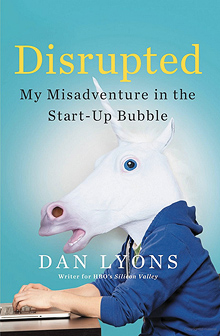 Disrupted: My Misadventure in the Start-Up Bubble By Dan Lyons Hachette ~ 2016 ~ 272 pp. $27 (cloth), $16 (paper) |
A decade ago, Dan Lyons had a good job and a great side gig: he was a tech journalist and was pseudonymously writing a wildly popular parody blog (“The Secret Diary of Steve Jobs”). But he wrapped up the blog in 2008, and a few years later a downsizing Newsweek canned him. He decided to leave journalism so that he could at last make some money, and after a few months found himself working for the tech firm Hubspot. The offices of the Cambridge, Massachusetts-based marketing company had all the sweet amenities that startups use to lure young employees — foosball, ping pong, free beer, a nap room, a “candy wall,” a music room “in case people want to have an impromptu jam session” (which they never did), and more. Lyons, in his early 50s, was “exactly twice the age of the average Hubspot employee” and found the setting and his colleagues both juvenile and threatening. His quarter-century as a skeptical journalist did not prepare him to work among the “super cheery cheerleaders” of Hubspot’s marketing department; he was put off by his young coworkers’ “peppy, effervescent, relentlessly positive, incredibly hubristic and overconfident attitude.”
Lyons’s whole experience at Hubspot was miserable, but at a depressing low point a friend from outside advised him to think of himself as an anthropologist, watching and studying. The resulting book detailing his observations and his suffering makes for hilarious reading. His bosses and peppy colleagues do not give the impression of being on the ball, and the company’s plans and purpose never seem to make much sense. After one office clash, Lyons is “banished”: his desk is moved into the company’s telemarketing space, which gives him the opportunity to highlight the glaring irony of a business that markets and sells supposedly hyper-advanced products for marketing and sales resorting to something as old-fashioned and brutish as telemarketing. “But we use our software…. We ‘eat our own dog food,’ as they say in the tech industry,” Lyons writes. “If our software really does what we claim,” why employ low-wage phone harassers?
Lyons explains how the “grow fast, lose money, go public, get rich” startup ethos can be wasteful and harmful. And if life at Hubspot sometimes sounds like the plot of an episode of Silicon Valley, that is not entirely a coincidence, since Lyons went on to be a writer and coproducer of the HBO series. Meanwhile, when some of Hubspot’s top executives heard that Lyons’s book was coming out, they tried unethically to obtain an advance copy; in the aftermath of its publication, one Hubspot executive resigned, another was fired, and the CEO was sanctioned by the board.
Antonio García Martínez offers a very different look at startup culture in his book Chaos Monkeys. It is certainly the best book written about twenty-first-century Silicon Valley; it may be the best book ever written about Silicon Valley. García quit his graduate studies in physics at Berkeley to take a job in finance. In 2008, he quit finance to move into tech, and before long cofounded a small company, which became Twitter’s third acquisition — but as that deal was happening, García bailed to go work for Facebook. His tenure at Facebook was enormously frustrating, and had he gone along with his former colleagues to Twitter, he might well have ended up happier and wealthier.
In telling the tale of his own startup and his time at Facebook, García gives us a sense of the intense dynamics of company founders, complete with betrayal and backstabbing. He describes the Valley culture of hippie capitalists and the young-hacker “piratical” culture of Facebook. He explains how Facebook tries to keep “pornography, spam, hate speech, and general human detritus” away from most users; he offers a primer on the history of web advertising and today’s search-engine advertising industry; and he explains why Facebook’s initial public offering, reported in the financial press as a disaster, was in fact a huge win for the company’s stock-option-owning employees. His experiences with Y Combinator, the famous startup incubator, are fascinating. Some tech writers don’t get economics, and some economics writers don’t get tech; he gets both.
García is a writer of immense gifts; his book is mordant, wicked, funny, lewd, creative, self-aware, and packed with all the literary references you would expect of the son of a librarian. He has a penchant for aphorism (“Not every problem has an engineering solution. That doesn’t mean, of course, that you can’t sell one”; “Phone calls are yesses, emails are nos”; “Success forgives all sins”), and a proclivity toward brilliant, philosophical digressions and asides. An epic rant about how capitalism “desacralizes everything, robs the world of wonder, and leaves it as nothing more than a vulgar market,” is, so to speak, worth the price of admission.
That the author of Chaos Monkeys has an especially restless soul is obvious not only from his career but also from his family life, which seems to bring him no consolation. Perhaps writing does — and if we are lucky, he will find something worth saying in a second book.
 Dreamland: The True Tale of America’s Opiate Epidemic By Sam Quinones Bloomsbury ~ 2015 ~ 374 pp. $18 (paper) |
The opiate crisis is unlike any drug epidemic the United States has seen before. The death toll is over fives times what it was at the height of the crack epidemic. Overdoses recently surpassed car crashes as the leading cause of death by injury. More than two million people in the United States are addicted.
Sam Quinones’s Dreamland is an exquisitely reported account of two intertwining stories: a tiny Mexican town’s takeover of the American heroin trade with an entirely new playbook, and the revolution in prescriptions of pain pills that tore down professional, social, and chemical barriers that once kept their abuse in check.
The latter story is perhaps the more predictable, in that a conquest by Big Pharma is a tale we feel we’ve heard before (although never like this) — more innocent, in that the doctors mostly meant to help and the patients truly didn’t know what they were getting into; but more pernicious, in that those with tremendous power and authority failed to wield it responsibly, and in that its most significant developments took place within the law.
In 1980, a one-paragraph letter to the editor in the New England Journal of Medicine sowed the seeds of the crisis to come. The letter noted that according to an informal survey of twelve thousand hospital patients given opiates, only four had then become addicted. This one paragraph was widely and carelessly cited without context (to the chagrin of its own authors), becoming enormously influential despite its flimsiness. Doctors hoping to expand pain-management options for their patients seized on the letter to buttress their arguments. And when Purdue Pharma’s sales force got wind of it, it became their killer stat, the clincher to presentations made in thousands upon thousands of doctors’ offices and conferences. Thus did sloppy science and a promise that was too good to be true cause an industry to turn its back on “ten thousand years of reality.”
Meanwhile, the pills being so aggressively promoted were not your grandma’s opiates. Prior to the release of OxyContin in 1996, pills containing oxycodone — a synthetic morphine molecule — also contained acetaminophen or some other substance. This discouraged ramping up the dose so far that the other ingredients would cause liver damage, and likewise kept addicts from seeking it out. That all changed with OxyContin, whose timed-release formula was marketed as staving off addiction. Existing addicts quickly found, however, that they could crush the pills for an instant high. And new patients found themselves dependent on the drug, needing ever-increasing doses to achieve relief. Many of these new, unwitting addicts, such as high-school athletes treated for minor injuries, eventually experienced demand that outpaced their prescription or ability to pay for it on the street.
Enter the Xalisco Boys, a clean-cut, customer-service-oriented cartel of heroin traffickers that approached drug dealing like pizza delivery. Call a number, place an order, collect it from the driver at a safe and comfortable location, no fuss, no foul play. The “black tar heroin” they peddled, from the hills near their family farms in Mexico, was a highly affordable alternative to Oxy and other drugs, and was suddenly available to demographics never before vulnerable to heroin. In its way, their ingenious stealth expansion coast to coast, using corporate marketing and distribution rather than territorial violence, is a testament to entrepreneurship and a kind of dark American dream. And it may give pause to anyone inclined to believe that the worst fallout of the drug war lies in turf battles and overbearing law enforcement. You could hardly imagine a more pacific system, or one with more catastrophic consequences.
Weaving in and out of these two main threads are many more, from deindustrialization to pill mills to bereaved parents, all forming a tapestry of despair. The complexity of the story stands in contrast to the simplicity of its central character, the little morphine molecule, which so thoroughly becomes the sole focus of those unfortunate enough to meet it. All it wants is everything. It finds paths to proliferation in immigrant enterprise, corporate empire, physicians’ mercy, physicians’ greed, patients’ naïveté, addicts’ cunning, lack of jobs, fantastic financial opportunities, outside and inside medical and legal standards, physical lows, physical highs, among old junkies and among hitherto untapped markets, at every level of our society. Against its force, with our guard down, we didn’t stand a chance.
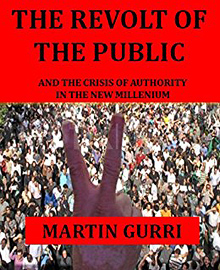 The Revolt of the Public and the Crisis of Authority in the New Millennium By Martin Gurri Amazon ~ 2014 $2.99 (e-book) |
This book is at bottom an effort to provide an overarching structure for the understanding of recent history, and to explain the technological and social bases for the dramatically changed world that we have been entering over the past three decades or so. Gurri argues for an understanding of history that is based not on the changing means of production, but the changing means of communication — more specifically, the changes in the development, control, and dissemination of information. For Gurri, controlling access to information is the basis of authority in human societies; and in the world that is now emerging around us, such control is being steadily lost, and with it, any certain basis for social and political authority. To wrestle with these changes, they must first be understood in the largest possible context.
Gurri believes there have been roughly five waves in the history of information organization. The first concerned the emergence of specialized knowledge, such as that of priests, shamans, healers, poets, and the like, operating within oral traditions. It was followed by the development of written languages, and the scribes and documents and legal institutions made possible by them. Next came Gutenberg’s revolution of movable type, and the development of mass publications and mass literacy that undergirded the ages of Reformation and Revolution. Fourth were the large professional and governmental organizations and information-making corporations, which certified and dispensed specialized knowledge and justified their authority by their expertise (reinforced by the occasional use of mass propaganda).
But finally, with the fifth wave of our own time, which has been characterized by the widest opening-up and dispersal of information in human history, all these sources of authority are being overthrown with no end in sight. For this assertion Gurri adduces a fascinating set of disparate phenomena ranging from the revolts of the Arab Spring to the discrediting of Dan Rather and CBS News, from economists’ incompetence leading to the Great Recession to the many ways — dietary recommendations, vaccinations, climate science — in which the authority of science has weakened in the public mind and “official” information based on expert knowledge is no longer regarded as especially credible. The fifth wave has proven to be a tsunami of incredible strength, and it has only just begun to crash upon us.
Gurri does not make predictions about how, or whether, we can resolve these problems. He does not prophesy what the road ahead will be. Instead, he sees us as wandering, in Matthew Arnold’s great words, between two worlds: one dying, another powerless (as yet) to be born. And he is worried about how, and whether, that which is best and most admirable in liberal democracy can withstand the changes that are now hard upon us. In this respect, his remarkable book reminds this reader of Alexis de Tocqueville, whose Democracy in America foresaw the emergence of democratic equality as a “providential” development, a dramatic change that could not be stopped — but who feared that the forces unleashed by democracy could well be self-undermining, and thus believed it to be imperative that we find the wisdom to channel the inevitable changes to come in ways that would conduce to the best outcomes possible. Such also is the goal of The Revolt of the Public, applying the Tocquevillean mission to the digital age. I commend it to your attention.
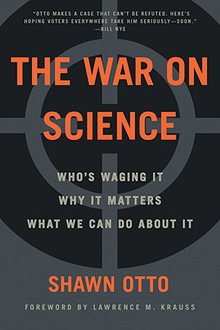 The War on Science: Who’s Waging It, Why It Matters, What We Can Do about It By Shawn Otto Milkweed ~ 2016 ~ 514 pp. $20 (paper) |
This is a silly book. Written by Shawn Otto (the man behind attempts to quiz presidential candidates about science in the last few elections), The War on Science takes the inchoate sentiment behind the smarmiest of “I f — cking love science” memes and makes of them some five hundred rambling pages of diatribe, invective, and platitudes.
To his credit, Otto tries, though not very hard, to avoid the outright partisanship of books like Chris Mooney’s The Republican War on Science or Alex Berezow and Hank Campbell’s Science Left Behind. “Politically, the war on science is coming from both left and right,” Otto writes, though he hastens to add that “the antiscience of those on the right … has far more dangerous public-policy implications.”
Otto shows a tenuous grasp of the subjects and arguments that he covers in the book. He devotes only a few paragraphs to a section on eugenics — the movement, led by American scientists, to control human reproduction through forced sterilization and other measures — but bizarrely even the brief discussion of this very important subject is used only to make a point about European suspicion of genetically modified crops, with Otto writing that “genetic engineering is, in Europe, still politically tied to the Nazi practice of eugenics, and therefore still causes strong political reactions.” People who are suspicious of the undue influence of scientific experts routinely use the catastrophe of American eugenics as an argument against putting scientists in charge of politics, and for good reason. But Otto appears to be unaware that arguments like this over the authority of science even exist.
The book’s treatment of the issue of when life begins — a controversy that is in part scientific and is vitally important to debates over embryo research as well as the politics of abortion — illustrates Otto’s tendentious and partisan understanding of the role of science in moral debates. He imagines a scientist asking a “fundamentalist” who believes that life begins at conception whether it is “still a life at the moment of fertilization, even if we know from careful observation that one-third to one-half of fertilized eggs never implant, and as many as three-quarters fail to lead to an ongoing pregnancy?” Even if most embryos do fail to implant and then die, why should that have anything to do with whether they are alive in the first place? There is simply no logical connection between the ostensibly high rate of early embryo mortality and the question of whether those embryos are living human beings.
If there really were a war on science, where are the forthright attacks upon it? One of Otto’s examples of an “antiscientific statement” made for political reasons is Rick Perry’s remark during the 2012 Republican primary campaign referring to the general consensus among climate scientists on global warming: “Galileo got outvoted for a spell.” Otto’s earnest response to Perry’s glib remark falls laughably flat:
It seemed lost on Perry that the people who “outvoted” Galileo were the members of the Roman Catholic Inquisition, who, like Perry, chose ideology over science. The US National Academy of Sciences had in 2010 stated that man-made climate change was supported by so many independent lines of data that its existence and causes should be “regarded as settled facts.”
Perry obviously meant to imply that institutions like the National Academy of Sciences are, like the Roman Catholic Inquisition, choosing ideology over science, while those few scientists who are skeptical of global warming are honest scientists like Galileo.
This is how debates over scientifically inflected political controversies tend to play out: partisans on both sides believe that their own position is the really “scientific” one, and they find some experts that will confirm their views. Anti-vaccine parents have their Andrew Wakefields, climate change skeptics have their Richard Lindzens, creationists have their Michael Behes. (And they’re all Galileo.)
By pushing a war-on-science narrative, activists like Otto both ignore and threaten the very real authority and trust science has in our society. Americans still put more trust in scientists than they do in almost any other group — certainly more than politicians or religious leaders. By transforming questions like “how much should we cut carbon emissions” into “science: for it or against it?,” those pushing the war-on-science narrative threaten to make their own inaccurately dire vision of political opposition to science come true.
 Too Like the Lightning: Terra Ignota Book I By Ada Palmer Tor ~ 2016 ~ 432 pp. $26.99 (hardcover)
|
In a market where dystopian science fiction is pretty much the norm, Ada Palmer says she has created a world that is “not a perfect future, but a utopian one.” It reflects a variety of Enlightenment values, and is “built on technologically-generated abundance” and high-speed private transportation. It is not difficult to see the elements of this future that could attract the left-leaning-libertarian nerds who seem to be a power in today’s sci-fi audience. The book is painfully politically correct, with lots of confusing uses of pronouns, gender bending, and wide sexual and lifestyle diversity, including transhuman modifications. There is also lots of cool technology, the nation-state is dead (replaced by tight associations of the like-minded), the public square is naked and religion completely privatized and individualized. And the clothes! Uniforms identify roles and allegiances, and the important people dress up, it seems, all the time so that everybody can know they are important.
Palmer acknowledges that to us her utopia looks like “a mad combination of heaven and hell,” but it is not entirely clear which elements of this future she thinks are hellish. The novel focuses on a handful of rich, famous, beautiful, and powerful people who are her world’s data-driven “central planners of inestimable subtlety.” So we are seeing much more than we do in Brave New World the lifestyles of the World Controllers. Palmer’s elite is every bit as manipulative as Huxley’s, if less unified; indeed, the main crux of the book is finding out who hacked the reputational index upon which basis they distribute power among themselves. But there is a strong sense that competition among them is part of the fun, just another way of feeding their obsessions with stuff, sex, and of course, power. That the elite at one point or another are shown committing all the mortal sins seems to be presented as just another sign of how deliciously transgressive they are.
As the plot develops it becomes ever clearer that the Enlightenment values that the book embodies extend beyond the philosophes to the Marquis de Sade. As her world controllers do philosophy and policy in the boudoir, it is far from clear that Palmer intends to show us the hellish consequences of a world where everything is possible and everything is permitted (at least, to some). Yet even though the frame narrative for this first novel in a series suggests we are seeing the moment of transition to a yet more politically correct utopia, Palmer, an intellectual historian at the University of Chicago, could still confound readers’ expectations. What does it mean, for example, that the most sympathetic character in the book is a seemingly repentant mass murderer, whose skills as a fixer are in high demand among the central planners, even as he has to hide from a general public that wants his blood? Or surely there is some irony that one of the devices that moves the plot is that this same character is hiding from his bosses a boy who can transform his thoughts into real things, thus giving him the power to “make his dreams come true” in an even more literal sense than they can. And in a world where some of the rulers are presented in near-godlike terms, how successful has the effort really been to make religion purely a private matter between each individual and his assigned spiritual counselor?
But if Palmer is sincere in claiming that her world of freedom from limits is utopian, there could not be a more telling contrast with Amor Towles’s charming and intelligent A Gentleman in Moscow. Count Alexander Ilyich Rostov (we hope a descendant of Count Nicholas Rostov) is condemned as a subversive by the Bolsheviks and put under house arrest in the Metropol Hotel. We watch him, from 1922 to 1954, dealing at first with the abrupt change in his own circumstances, and then with the increasingly inhumane consequences of the utopian project going on outside the confines of the hotel. Towles does not try to kid us; he makes clear that even under the new regime the Count is not merely endangered by his privileged position. But the hidden resources he draws upon to craft a beautiful and meaningful life for himself in the Metropol extend well beyond his supply of gold coins. While no Bertie Wooster, there is no reason to think that under the old regime the moral quality of the Count’s life might not have been endangered by the freedom and aimlessness which is the bane of the aristocratic gentleman; one indication of his resolve to meet the rigors of his new life is his decision to cut off his fashionable mustachios. Without giving away too much of the plot, it is precisely the narrowing of his horizons that forces the Count to draw upon and express all of his best inner resources: discipline, curiosity, resourcefulness, an attraction to excellence. Above all, we see the gentlemanly willingness to meet people (including children) respectfully on their own terms that makes him a much more serious egalitarian than any of the Soviet ideologues he encounters.
Palmer might be faulted if she really does not see just how petty, vain, and self-absorbed are the elite in her brave new word. Towles might be faulted for loving the Count a bit too much. But on the question of how limits are essential to a good human life, Towles wins hands down.
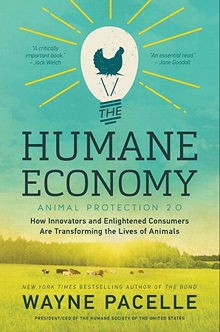 The Humane Economy: How Innovators and Enlightened Consumers Are Transforming the Lives of Animals By Wayne Pacelle William Morrow ~ 2016 ~ 352 pp. $26.99 (cloth), $16.99 (paper) |
When Wayne Pacelle, president of the Humane Society of the United States (HSUS), got cold-called by Wall Street shark Carl Icahn, he might have thought it was a prank. Instead, he took it as a sublime opportunity. Icahn, like millions of other Americans over the last few decades, had become increasingly concerned about animal cruelty, and dialed up Pacelle to see what he could do.
Pacelle picked a moonshot: help me get the attention of McDonald’s. Icahn got none other than the CEO on the line right away — “effortlessly … elevat[ing] the discussion of animal welfare from the office of social responsibility to the C-Suite” — and the three of them hashed out the first of many discussions that ultimately resulted in significant changes to company policy. McDonald’s agreed to stop sourcing from suppliers that crated their pigs and caged their hens. With such a pledge from such a leader (McDonald’s buys and sells over 3 percent of all U.S. eggs each year), competitors were forced to follow suit and farms with these more expensive standards faced less of a collective-action problem, nudging the whole industry in a more compassionate direction.
This is the “humane economy,” where systemic change is achieved not by legislative action (though HSUS lobbies for that as well) but by consumer preferences and corporate clout. Thanks to a public outcry that has been heard and registered by major companies, two leading pet-store brands have stopped selling cats and dogs altogether, cutting off the puppy-mill supply chains and allowing their stores to serve as adoption showrooms for shelter animals instead; many zoos, circuses, and aquariums are phasing out captivity of their most intelligent wards; researchers are deriving creative alternatives to animal testing and are trying to develop lab-grown meat; and more.
These “steady, meaningful steps” have a huge amount of animal suffering left to relieve, but the approach is an encouraging one. If the reader occasionally wonders whether Pacelle’s assessment is too optimistic, it is also clear that his openness and optimism are what help get things done. He reports how not one but two targets of previous HSUS undercover exposés, to whom he had an understandably hostile introduction, shocked him by turning right around and asking for his help in reforming their business models. Ever-ready to be friendly and productive, Pacelle buried the hatchet, hopped on a plane, met them where they were, and took it from there. This kind of constructive relationship across differences may seem like an endangered species. May it be defended, nurtured, reproduced, and helped to thrive again at large.
 The New Eugenics: Selective Breeding in an Era of Reproductive Technologies By Judith Daar Yale ~ 2017 ~ 265 pp. $40 (cloth) |
Just what, exactly, was wrong with eugenics, that late-nineteenth and early-twentieth century movement to improve the human race through the control of reproduction? As Daniel J. Kevles writes in his classic work on the subject, “‘eugenics’ has become a word of ugly connotations — and deservedly.” But just what we think those ugly connotations are makes a very big difference not only in how we view this dark piece of history, but also how we understand debates about reproductive technology today.
In a provocative new book, The New Eugenics: Selective Breeding in an Era of Reproductive Technologies, Whittier Law School professor Judith Daar offers a new set of lessons for us to draw from the eugenics era. The expression “new eugenics” has long been used to describe technologies like prenatal genetic diagnosis that can be used to identify and discard fetuses or embryos that are affected by genetic conditions that might cause disability or disease. By giving parents and doctors the power to prevent the birth of people with disabilities, many activists are concerned that such technologies represent a new way to achieve the same eugenic goals of “improving” the human race through the control of reproduction.
Others describe the use of these technologies as a so-called “liberal eugenics,” arguing that the problem with the old eugenics was that it violated the rights of would-be parents to make their own decisions about having children; since nowadays the state does not mandate the new “eugenic” technologies, then surely no one’s rights are violated. (The right to life of the fetuses or embryos that are killed when they are found to be genetically unfit is easy enough to ignore for liberals who support unfettered abortion access anyway.)
Daar argues that such concerns about the use of new technologies are overstated, and that, in fact, “The true eugenic impact of modern-day reproductive technologies is not in their use but in their deprivation” — too many individuals who would benefit from them don’t have access. If we see “procreative deprivation” as the chief evil of eugenics — and the way the state took away the ability of individuals to have children surely was evil — then Daar’s argument seems quite plausible. The state may not directly prevent people from having children today, but social circumstances bar many infertile people from accessing treatments that could help them have children. As Daar documents, fertility treatments are very expensive, and IVF doctors often refuse to provide treatment for the non-heterosexual, the non-married, and the disabled. If we think that people have something like a right to have children, or that it is bad for people who want children to be unable to have them, then public policies like anti-discrimination provisions or subsidies for fertility treatments may seem like reasonable ways to protect reproductive freedom.
Daar’s recommendations concerning surrogacy are hard to square with the idea that legal arrangements favoring greater access to reproductive technologies will enhance reproductive freedom. To describe how current legal arrangements interfere with reproductive freedom she tells the story of “a gay male couple [who] entered into a gestational surrogacy arrangement with the sister of one of the partners.” Despite the contracts and agreements made prior to the conception and birth of a pair of twins, “tensions and hostilities arose between the fathers and the surrogate/sister, culminating in the woman filing a petition seeking parental rights and custody.” The judge ruled that the surrogacy contracts were invalid, leaving the woman and the biological father (her brother’s partner) as the legally recognized parents of the children, which led to a custody fight in which the biological father was granted sole custody.
The government could perhaps make such surrogacy arrangements more clearly favorable to the parties contracting the surrogate, such that women in these positions would not be as able to sue for custody of the children they bear. This would make things easier for the “socially infertile” to use surrogates to have children, enhancing their reproductive freedom. But such legal arrangements would enhance their reproductive freedom precisely to the same extent that they would diminish the reproductive freedom of the surrogates who would then lose custody of their children in contested cases. A policy of maximizing reproductive freedom doesn’t offer much guidance for these cases, which are, after all, precisely the cases where changes in the law would be necessary.
Finding a balance between freedom and responsibility, and discerning just what the implications of reproductive technology are for human dignity and the meaning of the family, are genuinely difficult tasks. Restricting access to the kinds of treatments that would allow an infertile couple to have children really can seem morally comparable to preventing them from having children, though in cases where there are “third parties” like egg donors or surrogates, any putative right to have children is far more ambiguous. While the answers Daar poses are far from satisfactory, her book is well worth reading to stimulate deeper reflection on how best to deal with the challenges posed by reproductive technologies.
 Medical Catastrophe: Confessions of an Anesthesiologist By Ronald W. Dworkin Rowman & Littlefield ~ 2017 ~ 207 pp. $32.50 (cloth) |
The only reason a reader might put down this medical memoir unfinished is because the dramatic moments of hope and risk and despair from Ronald Dworkin’s career can be overwhelming — so a brisk walk or a nice cup of tea or some other restorative distraction is called for before plunging back in.
Among medical memoirs for a general readership, books by anesthesiologists are rare — we hear so much more from general practitioners, surgeons, and oncologists — so Dr. Dworkin’s account of his education and professional life refreshingly offers insights into this ubiquitous but little-understood specialty. Along the way, Dworkin, an occasional contributor to this journal, tackles some of the big questions: Is medicine a science? Is it an art? Is it manual labor? Is it just one dreadful, miserable thing after another? At times, it seems each of these, and the nobility of medicine can be obscured, especially in the darkest moments he chronicles.
The book sometimes feels like an exercise in catharsis, as if the author is unburdening himself of guilty feelings and grievances and petty slights and minor injustices, some decades old. But that is the point: such stories and sentiments make up an unavoidable but under-discussed part of the life of physicians (and nurses and other health care professionals). Dworkin’s chief interests are the politics of medicine — less in the sense of government and bureaucracy than in the sense of the incentives and interpersonal dynamics among physicians — and the slow discovering of what it takes to be a doctor. Smarts and skills, sure, but even more a doctor needs “natural inner strength.” That strength allows the good physician to make decisions in a crunch and to fight for them, and to keep going despite the inevitable deadly mistakes. To witness so much failure and stupidity — the “stupidity never ends,” he writes — and to experience so much frustration while avoiding cynicism is no small feat. Dr. Dworkin should be praised for offering a book that somehow manages to unite hopeful idealism and clear-eyed realism; aspiring physicians will learn much from it.
